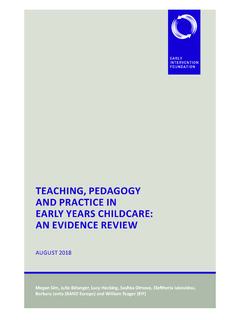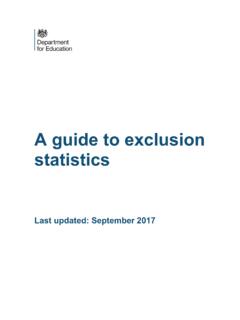Transcription of About the author
1 1 2 About the author Bobbie Mills is Senior Researcher in School System and Performance in EPI. Bobbie has five years of experience of research, evaluation and data analysis in the education policy sector. She is lead researcher on EPI s Features of Effective School Groups work programme, including authoring a working paper on measuring efficiency in school groups, and launching the EPI DEEP survey. Since joining EPI she has also authored Assessing Covid-19 cost pressures in England s schools , The relationship between the Kumon maths programme and Key Stage 2 maths outcomes in England and Boys studying modern foreign languages at GCSE in schools in England: Schools that are beating the odds . Acknowledgements This report has been sponsored by the National Education Union (NEU). The NEU represents more than 450,000 teachers, lecturers, support staff and leaders working in maintained and independent schools and colleges across the UK.
2 With additional thanks to colleagues at Education Policy Institute for their invaluable input in formulating this paper: Whitney Crenna-Jennings, Emily Hunt, and Jo Hutchinson. Thanks also to colleagues at NEU for their support, and also to colleagues at The Difference for their early input on this work. The analysis and interpretation presented in this paper is entirely the responsibility of EPI and not of our external associates. 3 Contents Introduction .. 5 School groups in England .. 5 Measuring pupil inclusion in school groups .. 6 School choice and admissions .. 11 What we know from existing research, data and methodological considerations .. 11 Our proposed metrics .. 14 Option 1: Odds ratios .. 14 Option 2: Logistic regression .. 17 Attendance and exclusions .. 21 What we know from existing 22 Absence and formal exclusion .
3 22 Unexplained exits .. 23 In-year admissions .. 24 Our proposed metrics .. 26 Persistent absence .. 26 Repeated fixed period exclusion .. 26 Permanent exclusion .. 26 Unexplained exits .. 28 In-year admissions .. 28 pupil achievement .. 30 What we know from existing 31 Our proposed metrics .. 32 Closing attainment 32 pupil attainment .. 33 Sustained destinations following 16-18 study .. 34 Methodological considerations all metrics .. 35 Contending with small numbers .. 35 Within-group variation .. 35 Contextualisation .. 36 Accounting for differing pupil intakes between school groups .. 36 Placing results in context of the national distribution .. 38 Presenting our results: Radar plots .. 39 Consultation: How to give feedback .. 43 4 Consultation questions .. 43 References .. 44 5 Introduction The majority of schools in England do not work in isolation.
4 Schools often work as part of wider groups and networks, such as academy trusts, federations, charitable trusts, dioceses, and other schools in the local authority. These different school groupings play an important role in the outcomes of young people in England, particularly the most disadvantaged, and yet little is known About how schools operate in groups effectively. Furthermore, much of the work to date on the performance of academy trusts and other types of school groups has focused on pupil progress and attainment. Less work has focused on assessing the inclusiveness of school groups, and this is partly due to challenges posed by methodological issues and lack of data. This discussion paper proposes a range of new metrics for assessing the inclusiveness of school groups in England, drawing on EPI s existing work and the broader evidence base.
5 We welcome feedback and details on the consultation can be found at the end of this paper. School groups in England Over three-quarters of secondary-aged pupils and nearly two in every five primary-aged pupils are now being educated in academies and free Nevertheless, academy trusts are just one way in which schools can be grouped together. A significant proportion of schools, particularly primary schools, remain outside the academy system. In 47 of the 152 local authority areas in England, less than a quarter of primary schools are part of academies or free Our mixed system also encompasses schools in federations, foundation school trusts, and those of religious denomination which have relationships with their diocese. Local authorities are also a type of grouping: schools in the same local authorities are not grouped by governance but nevertheless are linked through local communities, leadership networks and, not least, their relationships with their local children s services.
6 This relationship can influence a range of things including budget, admissions and school improvement. School groups are set to remain a key feature of the school system and will likely remain central to the government s school improvement strategy. We must get better at measuring effectiveness at group level. Our previous research projects have developed measures of school performance to compare school groups, specifically MATs with local authorities. Overall, we found little difference in the performance of the two types of grouping and concluded that the type of school academy or local authority is .. less important than being in a high performing school group .3 1 DfE, Schools, pupils and their characteristics , Academic Year 2020/21. 2 EPI analysis of Get Information About Schools , 4th November 2021, includes all-through schools and middle schools that are deemed primary.
7 3 Jon Andrews, School Performance in Academy Chains and Local Authorities - 2017 (Education Policy Institute, June 2018). 6 The question is therefore not which type of group is best, but which are the best examples of high performing individual groups. Previous work has also mainly focused on pupil progress and attainment, and on school improvement in terms of these pupil outcomes. This is a serious limitation in judging the effectiveness of school groups, as evidence gives us cause to suggest that the current school accountability system introduces perverse incentives which can lead to exclusionary practices, for example, the minority of secondary schools that appear to move pupils off their roll just before they sit their So the key follow-on question to which are the most effective school groups is which metrics should we prioritise when identifying the best examples of highly effective school groups.
8 We cannot look only at progress and attainment as these measures in isolation may mask practices which do not serve all pupils in the community. We must also look at positive examples of inclusion (and also workforce sustainability and financial efficiency, both of which form part of our overall program of work on the effectiveness of school groups). This working paper is part of a large-scale project by Education Policy Institute which aims to develop a range of robust metrics which enable us to identify the most effective school groups. We aim to identify the groups which not only enable strong pupil outcomes in terms of progress and attainment but do so whilst also achieving high standards in pupil inclusion, ensuring workforce sustainability and balancing financial efficiency. Measuring pupil inclusion in school groups This paper presents for discussion and feedback a detailed proposal of a suite of metrics which, taken together, aim to provide an accurate picture of a school group s progress towards achieving a high standard of pupil inclusion.
9 Our focus in this paper is on quantitative metrics which can be constructed using national administrative data. There are many important aspects of pupil inclusion which either are not suited to quantitative measurement or for which appropriate or reliable data does not exist; examples are behaviour policies, uniform and hair policies, the key stage 3 curriculum and safeguarding. As part of our broader research program, we will also be conducting a panel survey and in-depth qualitative interviews. School policies and Ofsted reports are also publicly available and can be referred to as we build up more detailed pictures of specific school groups. This qualitative work can plug this data gap to a certain extent, and we will look to link all these data sources up for individual school groups as we build our datasets.
10 Another area that is important to inclusion in schools, but which is not covered in detail in this paper, is the support of pupil wellbeing and mental health. The recent experience of the pandemic has highlighted the importance of wellbeing for enabling participation and learning. While this paper focuses on metrics which can be extracted from existing national data, we also wish to recognise the limitations of this data for capturing a full picture of pupil inclusion in schools. To help improve data 4 Jo Hutchinson and Whitney Crenna-Jennings, Unexplained pupil Exits from Schools: Further Analysis and Data by Multi-Academy Trust and Local Authority (Education Policy Institute, October 2019). 7 in the long term, EPI is working with other organisations and universities to build capacity and knowledge around tracking pupil wellbeing.









